A smartwatch is a versatile wrist-worn device combining traditional watch features with advanced smartphone integration, health tracking, and app functionality, designed to enhance daily convenience and productivity.
1.1 What is a Smartwatch?
A smartwatch is a wearable device that combines the functionality of a traditional watch with advanced smartphone features. It offers health and fitness tracking, notification alerts, app integration, and customization options. Designed to enhance convenience, smartwatches like the Apple Watch and Wear OS devices integrate seamlessly with smartphones, providing users with a sleek, portable tool to manage daily activities, monitor wellness, and access essential information on the go.
1.2 Benefits of Using a Smartwatch
A smartwatch enhances your daily life by offering health monitoring, fitness tracking, and personalized notifications. It streamlines productivity with voice assistants and app integration, allowing you to manage tasks efficiently. Customization options let you tailor the experience to your preferences, making it a versatile tool for both wellness and productivity. Whether you’re tracking workouts or staying connected, a smartwatch provides convenience and functionality at your wrist.
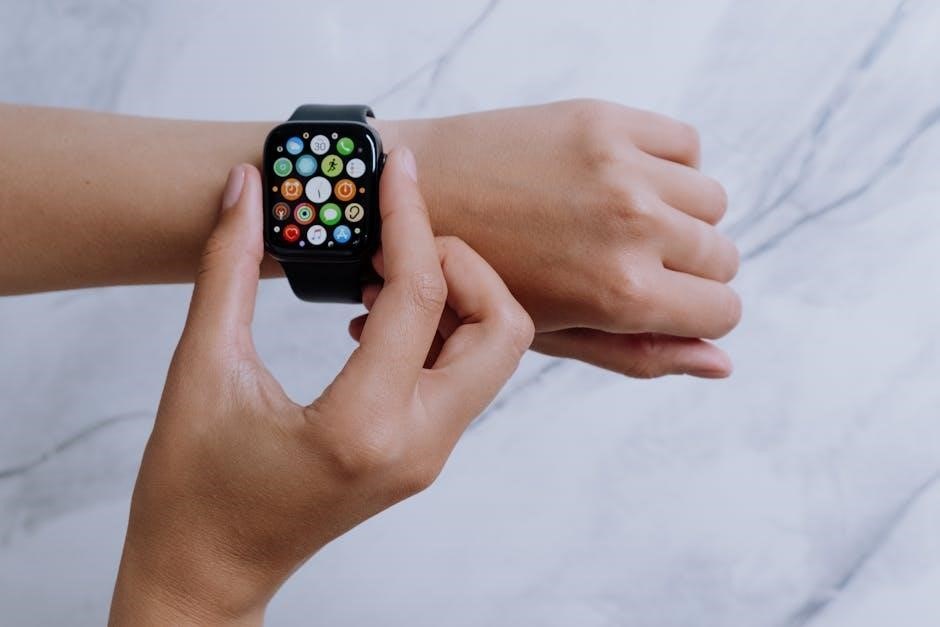
Setting Up Your Smartwatch
Setting up your smartwatch involves pairing it with your phone, syncing data, and configuring settings for optimal use. Follow on-screen instructions for a seamless experience.
2.1 Compatibility Check: iOS and Android
Ensure your smartwatch is compatible with your phone’s OS. Apple Watches pair exclusively with iPhones via the Apple Watch app, while Android-compatible smartwatches use Wear OS or Galaxy Wearable apps. For Android, enable Bluetooth and open the respective app to pair. Note that Wear OS 3 devices aren’t compatible with the Wear OS app. Always check manufacturer guidelines for specific pairing requirements and ensure your devices meet the necessary software version standards for seamless connectivity;
2.2 Pairing Your Smartwatch with Your Phone
To pair your smartwatch, bring it close to your phone and turn it on. For Apple Watches, open the Apple Watch app on your iPhone and follow on-screen instructions to pair. For Android smartwatches, use the Wear OS app, tap “Set it up,” and select your watch’s name from the list. If prompted, confirm the pairing code on both devices. Once paired, your watch will sync notifications and apps, enabling seamless integration with your phone. Ensure Bluetooth is enabled for a stable connection.
2.3 Initial Setup and Configuration
After pairing, select your language and agree to the terms of service. Follow on-screen instructions to set up features like Siri, Apple Pay, or health tracking. For Wear OS, choose your Google Account and enable permissions. Customize settings like notification preferences and app layouts. Ensure watchOS or Wear OS is updated for the latest features; Complete the setup by enabling health metrics and security options like a passcode. Your smartwatch is now ready for daily use with personalized configurations and enhanced functionality.
2.4 Syncing Data Between Devices
To sync data, ensure Bluetooth is enabled on both devices. For Apple Watch, open the Apple Watch app on your iPhone and tap “Pair” to start syncing. For Wear OS, use the Wear OS app to connect and sync data. Health metrics, notifications, and settings will automatically sync once paired. Periodically check connectivity to ensure seamless data transfer. If issues arise, restart both devices or re-pair them to refresh the connection and resume syncing effortlessly.
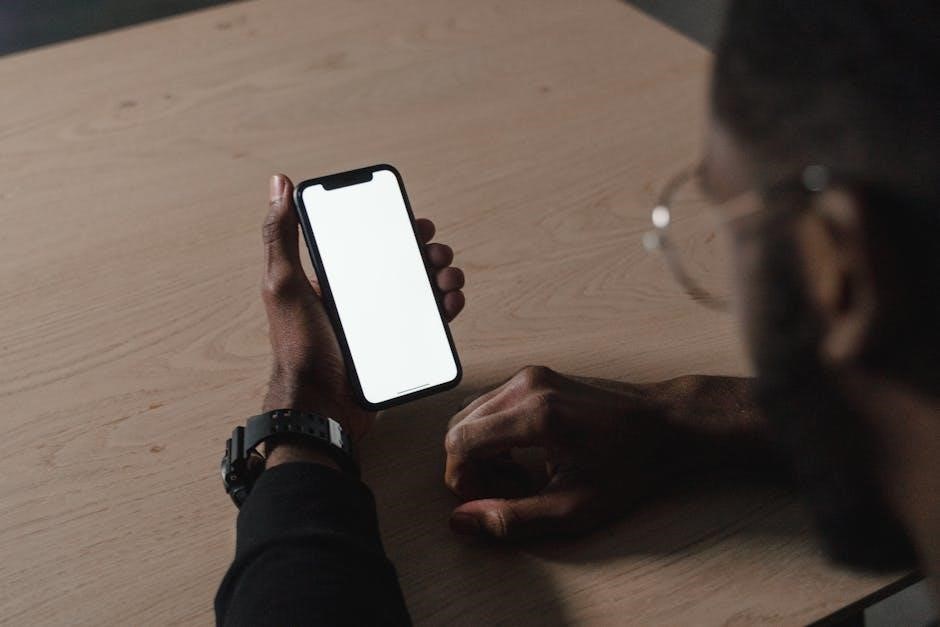
Health and Fitness Features
Syncing data ensures seamless integration between your smartwatch and phone. Enable Bluetooth on both devices, then use the Apple Watch app for iOS or Wear OS app for Android. Pair the devices to sync health data, notifications, and settings automatically. Regular syncing maintains up-to-date information across devices. If issues occur, restart both devices or re-pair them to refresh the connection and resume syncing smoothly for consistent functionality.
3.1 Tracking Your Daily Activity
Smartwatches track daily activity through built-in sensors, monitoring steps, calories burned, and distance traveled. They detect movement and classify activities like walking or running. Enable motion tracking in settings to log exercises automatically. Pair with your phone to sync data and view detailed insights. Customize goals for steps and calories to stay motivated. Regular tracking helps maintain accountability and promotes a healthier lifestyle by providing clear metrics on your progress throughout the day.
3.2 Monitoring Heart Rate and Other Health Metrics
Smartwatches come equipped with sensors to monitor heart rate, allowing continuous or periodic checks. Enable heart rate notifications to track trends and detect irregular rhythms. Some models also measure blood oxygen levels, providing deeper health insights. Access these metrics through the health app or built-in features. Use the digital crown or side button to initiate readings. Regular monitoring helps identify patterns and supports early detection of potential health issues, empowering users to make informed decisions about their well-being.
3.3 Setting Up and Using Exercise Tracking
Open the Workout or Activity app on your smartwatch to access exercise tracking. Select the type of workout, such as walking, running, or cycling. Tap Start to begin tracking duration, heart rate, and calories burned. View real-time metrics on the watch face or through the paired smartphone app. Customize settings like workout goals or alerts for a tailored experience. Regular use helps monitor fitness progress and achieve health objectives effectively.
3.4 Customizing Health and Fitness Goals
Set personal health and fitness objectives using the smartwatch app on your phone. Define goals for daily steps, exercise minutes, or calorie burn. Access the Goals section in the app, adjusting targets to suit your lifestyle. Enable alerts for progress reminders and milestone achievements. Customize metrics like heart rate zones or workout intensity. Track progress summaries weekly to stay motivated. Tailor your goals to align with specific wellness priorities, ensuring a personalized fitness journey.
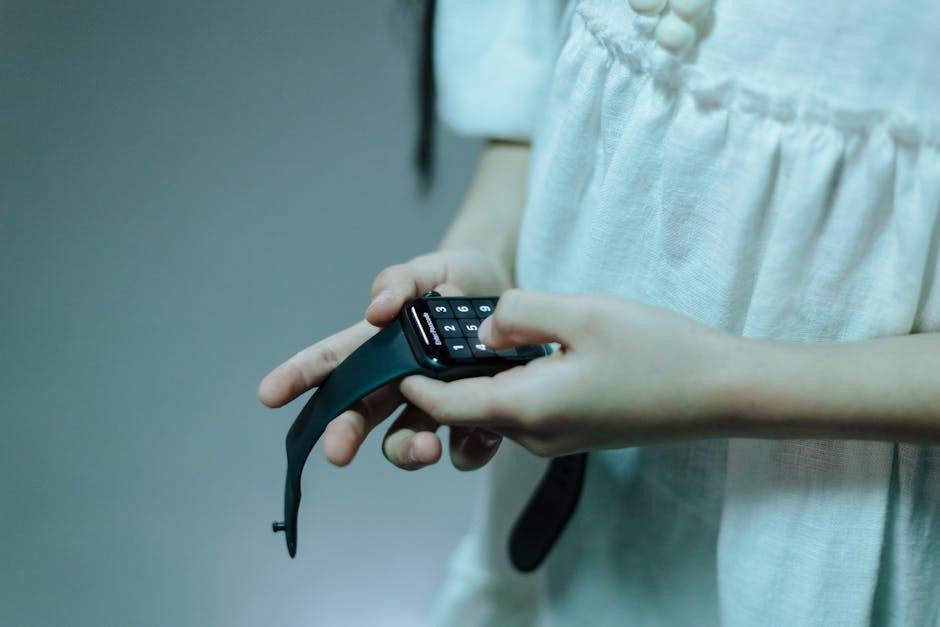
Productivity Tools
Smartwatches offer productivity tools like notification management, app integration, voice commands, and customizable layouts, helping users streamline tasks and stay efficient on the go.
4.1 Managing Notifications
Smartwatches allow users to manage notifications directly from their wrist, ensuring they stay informed without constant phone checks. Users can customize notification settings, enabling or disabling alerts from specific apps. The Wear OS app and Apple Watch settings offer tools to filter notifications, ensuring only important alerts appear. Additionally, features like “Do Not Disturb” modes or notification summaries help minimize distractions. These options enhance productivity by keeping users focused while maintaining connectivity.
4.2 Using Built-in Apps
Smartwatches come with built-in apps designed to enhance productivity and convenience. Users can access fitness trackers, music controllers, and mobile payment tools like Apple Pay. Built-in apps on Wear OS and Apple Watch allow quick access to essential features without needing a phone. These apps integrate seamlessly with the watch’s interface, offering a streamlined experience for tasks like setting reminders or monitoring health metrics, ensuring users can manage their day efficiently from their wrist.
4.3 Voice Assistant Integration
Smartwatches often integrate voice assistants like Siri or Google Assistant, enabling hands-free control. Users can issue voice commands to set reminders, send messages, or access information. On Apple Watch, Siri can be activated by raising the wrist or using the “Hey Siri” phrase. For Wear OS devices, Google Assistant provides similar functionality. This feature enhances convenience, allowing users to perform tasks without needing their phone nearby. Voice assistant integration streamlines interactions, making smartwatches more intuitive and user-friendly. Proper settings must be configured for optimal performance.
4.4 Customizing App Layouts
Smartwatches allow users to customize app layouts for convenience. Organize apps by frequency of use or category, and add widgets for quick access to information like fitness stats or notifications. On Apple Watch, press and hold the home screen to edit layouts, while Wear OS devices often enable reorganization through the settings menu. Customize your interface to prioritize essential apps and features, ensuring a seamless and personalized experience tailored to your daily needs and preferences.

Customization Options
Smartwatches offer extensive customization options, allowing users to personalize watch faces, notification settings, and app layouts. Adjust widgets, themes, and general settings to suit your style and needs perfectly.
5.1 Choosing and Adjusting Watch Faces
To personalize your smartwatch, explore various watch faces that suit your style. On Apple Watch, press and hold the screen to access the customization interface. For Wear OS devices, use the companion app to download and switch faces. Adjust colors, complications, and layouts to match your preferences. Ensure your watch face aligns with your phone’s language settings for consistency. This feature allows you to tailor your smartwatch’s appearance to fit your lifestyle and aesthetic seamlessly.
5.2 Personalizing Notification Settings
Customize your smartwatch notifications to prioritize important alerts and minimize distractions. On Apple Watch, use the Watch app on your iPhone to enable or disable notifications for specific apps. For Wear OS devices, manage notifications through the companion app or directly on the watch. Adjust settings to mirror your phone’s notifications or tailor them uniquely for your wrist. Additionally, enable “Do Not Disturb” mode to silence alerts during specific times, ensuring your smartwatch enhances your productivity without overwhelming you with unnecessary alerts.
5.3 Organizing and Adding Widgets
To enhance your smartwatch experience, customize your home screen with widgets. On Apple Watch, touch and hold the screen, then tap the “+” icon to add widgets like fitness trackers or music controls. Rearrange widgets by holding and dragging them. For Wear OS devices, swipe up to view tiles, tap “+” to add new ones, and press-hold to move or remove them. Organize widgets to streamline access to your most-used apps, ensuring a personalized and efficient interface for daily use. This feature boosts productivity and convenience on your wrist.
5.4 Adjusting General Settings

Adjusting general settings on your smartwatch enhances functionality. On Apple Watch, open the Settings app to tweak brightness, screen timeout, and haptic feedback. For Wear OS, access settings by swiping down or using the companion app. Customize display preferences, notification filters, and system updates. Ensure your watch runs smoothly by reviewing storage, battery optimization, and connectivity options. Tailor these settings to match your lifestyle, improving both performance and user experience for everyday wear and use.
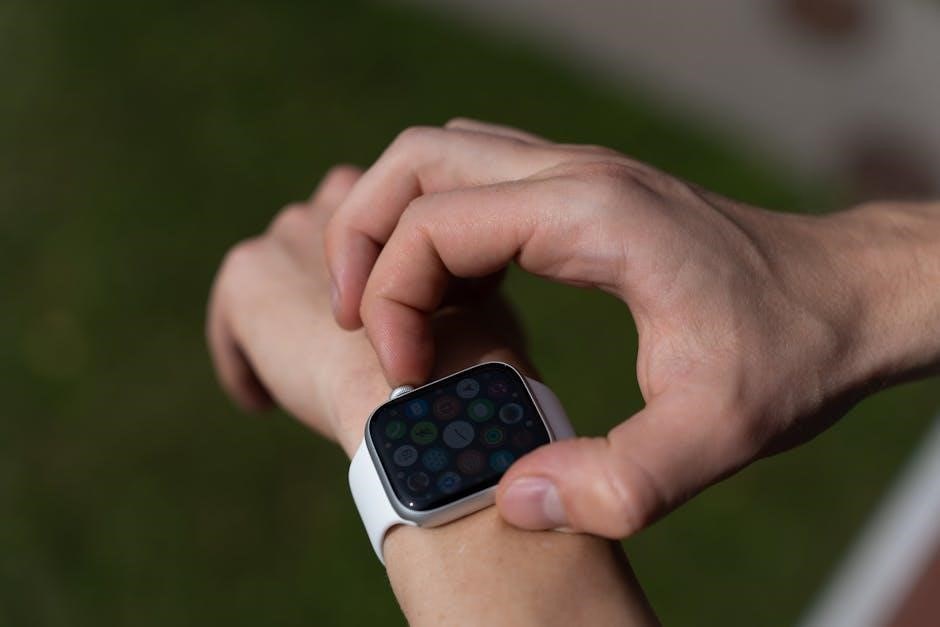
Advanced Features
Explore advanced smartwatch features like mobile payments, music control, and smart device integration. These tools enhance convenience, enabling seamless connectivity and multitasking on the go.
6.1 Using Mobile Payments
Smartwatches support mobile payment systems like Apple Pay and Google Pay, allowing contactless transactions. Open the respective app, add your card, and authenticate. Payments are secure, using tokens instead of actual card numbers, and can be made with a double-click or wrist gesture. This feature is convenient for quick purchases without needing your phone or wallet. Ensure your bank supports the service and follow setup instructions for seamless integration.
6.2 Controlling Music Playback
Smartwatches enable seamless music playback control, allowing you to play, pause, skip tracks, and adjust volume directly from your wrist. Open the music app on your smartwatch or use the Now Playing widget. Pair your watch with Bluetooth headphones for wireless listening. You can also customize playlists and access music libraries stored on your device. Voice commands via Siri or Google Assistant further enhance convenience, making it easy to manage your music experience on the go.
6.3 Integrating with Other Smart Devices
Smartwatches can seamlessly integrate with other smart devices, enhancing your connected lifestyle. Pair your watch with Bluetooth headphones for wireless music, or connect to smart home systems to control lights and thermostats. Use voice commands to interact with compatible devices, ensuring a hands-free experience. Additionally, integrate with fitness equipment or other wearables to synchronize data and create a unified ecosystem. This integration allows for a more convenient and streamlined smart experience, keeping you connected across all your devices.

Troubleshooting Common Issues
Common smartwatch issues include connectivity problems, battery drain, and app malfunctions. Restarting the device often resolves these. For persistent issues, reset settings or seek support resources.
7.1 Resolving Connectivity Problems
If your smartwatch disconnects from your phone, restart both devices. Forget the device in Bluetooth settings and re-pair it. Ensure both devices are updated and in range. Clearing cache or resetting network settings can also resolve issues. For persistent problems, consult the user guide or contact support for further assistance.
- Restart your smartwatch and phone.
- Forget the device in Bluetooth settings.
- Re-pair your smartwatch following setup instructions.
7.2 Fixing Battery Life Issues
To improve your smartwatch’s battery life, reduce screen brightness and disable the always-on display. Limit unnecessary app refresh and background activity. Enable low-power mode during extended use. Ensure your device is updated to the latest OS for optimized performance. Monitor battery health and replace the battery if needed. Avoid extreme temperatures and overcharging, as these can degrade battery performance. Regularly review battery usage stats to identify and close power-hungry apps or features.
- Dim the screen or turn off always-on display.
- Disable unnecessary app refresh and background activity.
- Enable low-power mode for extended use.
7.3 Resetting Your Smartwatch
Resetting your smartwatch restores it to factory settings, resolving persistent issues. On Apple Watch, open Settings > General > Reset and tap “Erase All Content and Settings.” For Wear OS devices, go to Settings > System > Reset > Factory reset. Ensure your data is backed up before proceeding. This action removes all apps, settings, and personal data. After resetting, set up your smartwatch again to restore functionality and pair it with your phone.
- Backup data before resetting.
- Follow device-specific reset instructions.
- Set up the watch again post-reset.
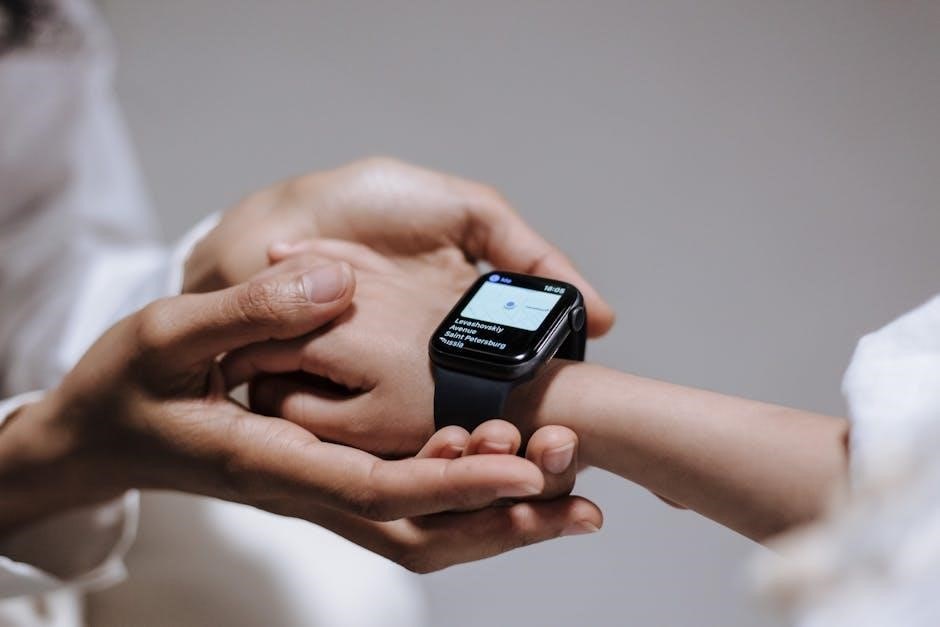
Security and Privacy Settings
Secure your smartwatch with a passcode, manage data privacy settings, and enable remote wiping for added protection. Regular software updates ensure optimal security and functionality.
8.1 Setting Up a Passcode
Setting up a passcode on your smartwatch enhances security, protecting your data from unauthorized access. Open the Settings app, scroll to “Passcode,” and select “Turn On Passcode.” Choose a numeric or alphanumeric code, ensuring it’s unique and secure. For Apple Watch, use the Watch app on your iPhone to enable this feature. Regularly update your passcode and avoid sharing it to maintain privacy. This step is crucial for safeguarding personal health metrics, payments, and notifications, ensuring your smartwatch remains secure and private.
8.2 Managing Data Privacy
Managing data privacy on your smartwatch involves controlling what information is collected and shared. Review the privacy settings in the companion app, enabling features like data encryption and limiting third-party app access. Regularly check which apps have permission to access health metrics, location, or notifications. For Apple Watch, use the Health app to adjust sharing preferences, while Wear OS users can modify permissions through the Google Fit settings. Ensuring your data remains private is essential for maintaining security and trust in your device.
8.3 Remote Wiping Your Smartwatch
Remote wiping your smartwatch allows you to erase all data if it’s lost or stolen. For Apple Watch, use the Find My app or iCloud to erase the device. On Wear OS, go to the Google Settings app, select Account and Backup, and choose Factory Reset. This process removes all apps, settings, and personal data, restoring the watch to factory settings. Ensure you back up important data before performing a remote wipe to avoid permanent loss of information.
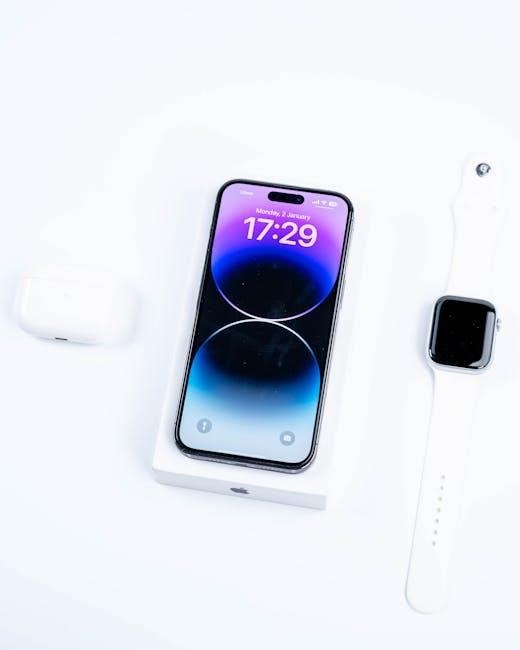
Additional Tips and Tricks
Explore hidden features, optimize battery life, and customize watch faces to enhance your smartwatch experience. Regular updates ensure the latest security and functionality improvements are installed automatically.
9.1 Optimizing Battery Life
To maximize your smartwatch’s battery life, adjust screen brightness, enable low power mode, and limit unnecessary notifications. Disable always-on display and GPS for non-essential tasks. Regularly close unused apps and update your watch’s software for efficiency improvements. Charge your device properly and avoid overcharging, which can degrade battery health over time. These simple tweaks ensure longer usage between charges, keeping your smartwatch powered throughout the day.
9.2 Keeping Your Smartwatch Updated
Regular updates ensure your smartwatch performs optimally, with improved features, security patches, and bug fixes. To update, open the companion app on your phone, select your watch, and follow on-screen instructions. For Apple Watch, use the Watch app; for Wear OS, use the Wear OS app. Ensure your watch is charged and connected to Wi-Fi or Bluetooth. Updates may take time but are essential for maintaining functionality and enhancing your user experience with the latest advancements.
9.3 Exploring Hidden Features
Discovering hidden features on your smartwatch can enhance your experience. For example, customize watch faces by long-pressing the screen or use gesture controls for quick access to apps. Some models allow you to enable “Raise to Speak” for Siri or adjust settings like screen brightness. Explore the Settings menu or visit the manufacturer’s website for tips and tricks to unlock these features and make the most of your smartwatch’s capabilities.
Your smartwatch is a powerful tool designed to enhance your daily life, offering health tracking, productivity features, and seamless connectivity. By exploring its capabilities and customizing settings, you can maximize its benefits. Stay updated with the latest software and discover new features to keep your smartwatch performing at its best. With proper care and optimization, your smartwatch will remain a valuable companion, helping you stay connected, motivated, and informed every step of the way.
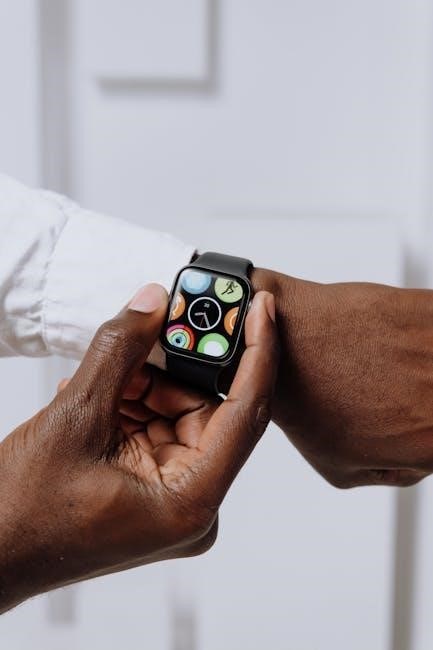



About the author